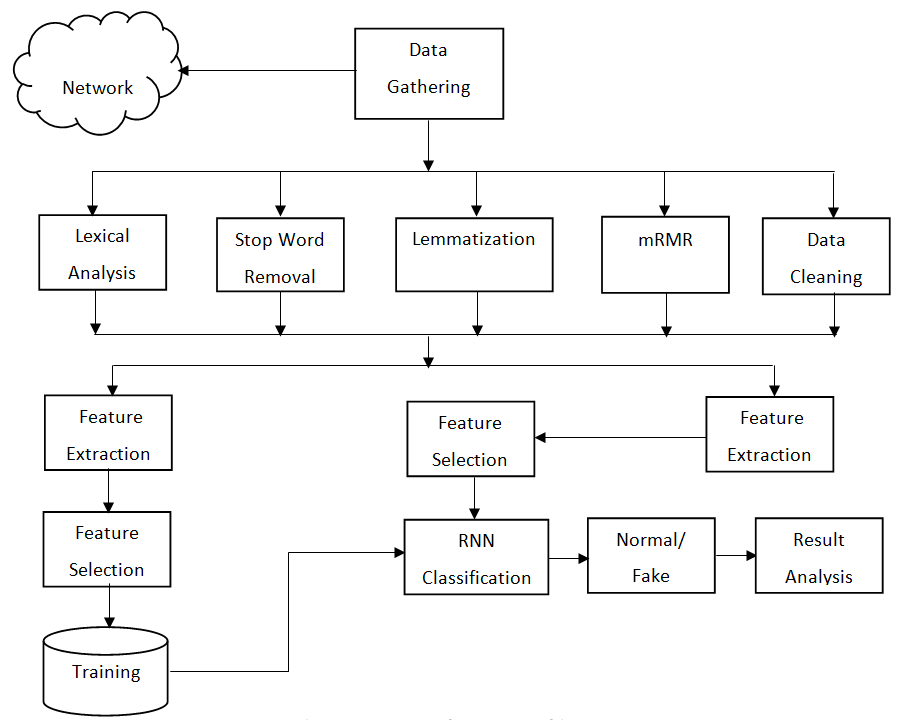Designing A Model for Fake News Detection in Social Media Using Machine Learning Techniques
Keywords:
Social media, fake news detection, machine learning, recurrent neural network, feature extraction and selection, classificationAbstract
Fake identity is a critical problem nowadays of social media. Fake news is rapidly spread by fake identities and bots that generate the trustworthiness issue on social media. Identifying the profiles and accounts using soft computing algorithms is necessary to improve the trustworthiness of social media. In this work, we proposed Recurrent Neural Network to identify fake identities on social media. Initially, we extract data from social media such as Twitter.com using Twitter API. Hybrid feature extraction has been done based on the characteristics of data. It generates training rules which are associated with a fake and legitimate profiles generated by a human. In pre-processing and filtration process, all bot entries are eliminated using a policy-based approach. To generate strict rules that improve the classification accuracy, the training of dataset primarily focuses on attributes such as friends count, the total number of followers, tweet counts, re-tweets count, etc., The Recurrent Neural Network (RNN) categorizes each profile based on training and testing modules. This work focuses on classifying bots or human entries according to their extracted features using machine learning. Once the training phase is completed, features are extracted from the dataset based on the term frequency on which the classification technique is applied. The proposed work is very effective in detecting malicious accounts from an imbalanced dataset in social media. The system provides maximum accuracy for the classification of fake and real identities on the social media dataset. It achieves good accuracy with Recurrent Neural Network (RNN) using the different activation functions. The system improves the classification accuracy with the increase in the number of folds in cross-validation. In experiment analysis, we have done testing on synthetic and real-time social media datasets; We achieve around 96% accuracy on the real-time Twitter dataset while 98% accuracy on synthetic social media datasets.
Downloads
References
Van Der Walt, Estée, and Jan Eloff. "Using machine learning to detect fake identities: bots vs humans." IEEE Access 6 (2018): 6540-6549.
Shu, Kai, et al. "The role of user profiles for fake news detection." Proceedings of the 2019 IEEE/ACM International Conference on Advances in Social Networks Analysis and Mining. 2019.
Islam, Mohammad Raihanul, Sathappan Muthiah, and Naren Ramakrishnan. "RumorSleuth: joint detection of rumor veracity and user stance." 2019 IEEE/ACM International Conference on Advances in Social Networks Analysis and Mining (ASONAM). IEEE, 2019.
Al Asad, Nafiz, et al. "Depression Detection by Analyzing Social Media Posts of User." 2019 IEEE International Conference on Signal Processing, Information, Communication & Systems (SPICSCON). IEEE, 2019.
Li, Neng, et al. "Fake reviews tell no tales? dissecting click farming in content-generated social networks." China Communications 15.4 (2018): 98-109.
Meshram, Shweta, Rajesh Babu, and Jayanth Adhikari. "Detecting Psychological Stress using Machine Learning over Social Media Interaction." 2020 5th International Conference on Communication and Electronics Systems (ICCES). IEEE, 2020.
Zarei, Koosha, Reza Farahbakhsh, and Noël Crespi. "Typification of impersonated accounts on instagram." 2019 IEEE 38th International Performance Computing and Communications Conference (IPCCC). IEEE, 2019.
Elghanuni, Ramzi H., Musab AM Ali, and Marwa B. Swidan. "An Overview of Anomaly Detection for Online Social Network." 2019 IEEE 10th Control and System Graduate Research Colloquium (ICSGRC). IEEE, 2019.
Gheewala, Shivangi, and Rakesh Patel. "Machine learning based Twitter Spam account detection: a review." 2018 Second International Conference on Computing Methodologies and Communication (ICCMC). IEEE, 2018.
Daha, Fatima Zohra, and Saniika Hewavitharana. "Deep neural architecture with character embedding for semantic frame detection." 2019 IEEE 13th International Conference on Semantic Computing (ICSC). IEEE, 2019.
Fazil, Mohd, and Muhammad Abulaish. "A hybrid approach for detecting automated spammers in twitter." IEEE Transactions on Information Forensics and Security 13.11 (2018): 2707-2719.
Aydin, Ilhan, S. E. V. İ. Mehmet, and Mehmet Umut Salur. "Detection of Fake Twitter Accounts with Machine Learning Algorithms." 2018 International Conference on Artificial Intelligence and Data Processing (IDAP). IEEE, 2018.
Sowmya, P., and Madhumita Chatterjee. "Detection of Fake and Clone accounts in Twitter using Classification and Distance Measure Algorithms." 2020 International Conference on Communication and Signal Processing (ICCSP). IEEE, 2020.
Pakaya, Farhan Nurdiatama, Muhammad Okky Ibrohim, and Indra Budi. "Malicious Account Detection on Twitter Based on Tweet Account Features using Machine Learning." 2019 Fourth International Conference on Informatics and Computing (ICIC). IEEE, 2019.
Akyon, Fatih Cagatay, and M. Esat Kalfaoglu. "Instagram Fake and Automated Account Detection." 2019 Innovations in Intelligent Systems and Applications Conference (ASYU). IEEE, 2019.

Downloads
Published
How to Cite
Issue
Section
License
Copyright (c) 2023 A Kumari Shalini, Sameer Saxena, B Suresh Kumar

This work is licensed under a Creative Commons Attribution-ShareAlike 4.0 International License.
All papers should be submitted electronically. All submitted manuscripts must be original work that is not under submission at another journal or under consideration for publication in another form, such as a monograph or chapter of a book. Authors of submitted papers are obligated not to submit their paper for publication elsewhere until an editorial decision is rendered on their submission. Further, authors of accepted papers are prohibited from publishing the results in other publications that appear before the paper is published in the Journal unless they receive approval for doing so from the Editor-In-Chief.
IJISAE open access articles are licensed under a Creative Commons Attribution-ShareAlike 4.0 International License. This license lets the audience to give appropriate credit, provide a link to the license, and indicate if changes were made and if they remix, transform, or build upon the material, they must distribute contributions under the same license as the original.





